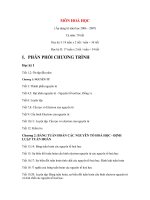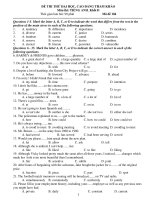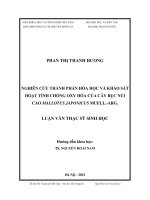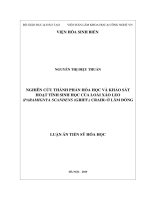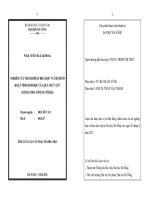Nghiên cứu T.Anh cao học (tham khảo)
Bạn đang xem bản rút gọn của tài liệu. Xem và tải ngay bản đầy đủ của tài liệu tại đây (184.83 KB, 8 trang )
bộ giáo dục và đào tạo
trờng Đại học nông nghiệp I
&
đề thi tuyển sinh sau đại học năm 2005
Môn thi : tiếng Anh, Đề Số 303
Thời gian làm bài : 120 phút
Họ và tên thí sinh : Đáp án
Ngày tháng năm sinh :
Nơi sinh :
Số báo danh :
Ngày thi : 07/5/2004
Chữ ký Giám thị 1 Chữ ký Giám thị 2 Số phách
"
========================================
Điểm
Số phách
Bằng số Bằng chữ
Part I: reading
SECTION A: Choose the word or phrase which best completes each sentence by circling the
letter next to the word that best fits each space. Give one answer only to each question. (15
điểm, mỗi câu 1 điểm)
1. My brother is busy .. his exercises.
A. doing B. in doing C. at writing D. to write
2. She .. for a job for months before she found one.
A. was looking B. looked
C. would have been looking D. had been looking
3. If they had enough money, they that house.
A. would buy B. will buy C. bought D. buy
4. I must go to the laundry and .. my washing.
A. bring B. clean C. collect D. carry
5. My brother did not go to school yesterday. Neither .
1
A. went I B. did I C. I did D. I went
6. When did you come here?“ ” - I here since last Sunday.“ ……………… ”
A. have been B. was C. have D. had been
7. We did not go to the cinema yesterday it was raining.…………………
A. if B. unless C. for D. because
8. Students should answer five of the . ten questions.…………………
A. below B. following C. under D. added
9. Those people are working .…………………
A. hard B. hardly C. hardily D. hardness
10. Did he tell you how much . ?……………………
A. does the book cost B. did the book cost
C. the book costs D. the book cost
11. We shall have to hurry or we shall . the bus.………………
A. catch B. delay C. miss D. wait
12. .. all his problems, he never allowed himself to lose heart.………………
A. As for B. Despite C. Nevertheless D. Granted
13. This is the best play . I have ever seen.…………………
A. where B. what C. when D. that
14. She did not . the gift. She turned it down.………………
A. except B. accept C. expect D. excerpt
15. It was .. bad weather that we could not go out.…………………
A. very B. so C. too D. such
SECTION B: reading passages
Passage 1: Read the following passage and answer the questions that follow:
THE EFECTS OF TSUNAMI (5 ®iÓm, mçi c©u 1 ®iÓm)
On December twenty-sixth last year, a powerful earthquake sent waves across southern Asia and
eastern Africa. At least one hundred sixty thousand people in eleven countries were killed. Many more
lost their homes. Indonesia, Sri Lanka and Thailand suffered the most damage.
Many health officials warned about the possible spread of diseases after the tsunami waves (sãng
thÇn) in the Indian Ocean in December. W.H.O. officials say international efforts to provide clean water
have helped limit the spread of infections. So have shipments of medicine and mosquito-control
supplies.
But the W.H.O. says people are still at great risk of diseases such as cholera (bÖnh t¶), malaria and
dengue fever (sèt xuÊt huyÕt). Dengue fever and malaria are spread by the bite of mosquitoes. Cholera
is an intestinal infection (bÖnh ®êng ruét) spread through water polluted with bacteria.
Another big concern involves the emotional condition of tsunami survivors. Experts say stress-related
disorders such as fear or depression can continue for several years if people do not get help.
COMPREHENSION QUESTIONS
2
Answer the following questions:
16. What happened on December the twenty-sixth last year?
(On December the twenty-sixth last year,) a powerful earthquake sent waves across southern Asia and
eastern Africa.
17. What were the losses?
At least one hundred sixty thousand people in eleven countries were killed. Many more lost their
homes.
18. What are international efforts for?
International efforts are to provide clean water to limit the spread of infections.
19. How are the diseases spread in the tsunami-hit areas?
Dengue fever and malaria are spread by the bite of mosquitoes. Cholera is spread through water
polluted with bacteria.
20. What is the emotional condition of tsunami survivors?
They suffer from stress-related disorders such as fear or depression
Passage 2 : Read the passage below and circle the letter next to the word that best fits each space :
(10 ®iÓm, mçi c©u 1 ®iÓm)
Read the article below and circle the letter next to the word that fits each space.
EXAMPLE: The .. between the acts was twenty minutes long.……………
A. time interval C. space D. pause
“The Moon Trap is a new film made by a young Canadian (21) called Melvin” ……………
Strang. The main parts in the film are (22) . by Sid Cheung and Julie Plein who last………………
appeared in Music For Ever .“ ”
In this new film (23) .. star as a young married couple who buy an old house in…………………
the country. After living there (24) . A few weeks strange things begin to happen.……………………
Some of the furniture in the house disappears and can t be (25) . ; windows break’ ………………
and pictures fall off walls. At night they (26) .. crying noises, and when the moon is up……………………
loud screams can be heard from the woods nearby.
As you might expect, the young couple try to discover the (27) . For all these…………………
strange events and this leads them into some very frightening situations. (28) you are…………………
easily scared don t go and see this film! But if you enjoy films with (29) of adventure’ …………………
and murder (30) .. this is the film for you.………………
21. A. actor B. leader C. director D. manager
22. A. played B. given C. made D. put
23. A. the B. they C. she D. them
24. A. since B. from C. for D. by
25. A. taken B. moved C. made D. found
26. A. hear B. make C. seem D. sound
27. A. way B. course C. reason D. use
28. A. Why B. If C. How D. Because
29. A. lots B. much C. many D. all
3
B
.
30. A. as B. when C. than D. then
Passage 3 : Read the following text and look at Questions 31-40 to decide if each statement is
TRUE or FALSE. (10 ®iÓm, mçi c©u 1 ®iÓm)
SELECTIVE REFLECTION (pH¶N X¹/CHIÕU CHäN LäC)
We can see an object only when a light shines on it. The surface of a particular object will
absorb some of this light s wavelengths (b’ ước sóng) and reflect others. This process is known as
selective reflection. The colour we see is the colour that is reflected. To illustrate this, let us consider
the colours of a tree. The leaves appear green because all other wavelengths of the light hitting them
are absorbed (hấp thụ). The trunk of a tree appears brown because brown is the only wavelength
which is reflected.
The only two colours we see that are not the product of selective reflection are black and white.
When a surface absorbs all the wavelengths of a light source, that surface appears black. When it
absorbs none, it appears white.
True False
31 The passage defines wavelengths.
x
32 The passage explains why some surfaces absorb certain
wavelengths and reflects others.
x
33 The word selective implies that only some wavelengths are“ ”
reflected.
x
34 Leaves look green to us because this colour is absorbed while
all others are reflected.
x
35 The trunk of a tree appears brown because this colour is
reflected.
x
36 White does not reflect light selectively; it reflects all lightwaves.
x
37 An object will appear black because no wavelengths are
reflected.
x
38 An object will appear white when all the colours from a light
source are reflected from that object s surface.’
x
39 The six basic colours: red, orange, yellow, green, blue and violet
are probably all subject to the selective reflection process.
x
40 The page of this Test Paper reflects all the light that is shining
on it, but the words on the page absorb all the light.
x
Passage 4: Read the following passage and choose the right answer by circling the suitable letter
A,B,C, or D space in the Questions 41-45.
THE NOBEL PRIZE (5 ®iÓm, mçi c©u 1 ®iÓm)
After inventing dynamite, Swedish-born Alfred Nobel became a very rich man. However, he
foresaw its universally destructive power too late. Nobel preferred not to be remembered as the
inventor of dynamite, so in 1895, just two weeks before his death, he created a fund to be used for
awarding prizes to people who had made worthwhile contributions to mankind. Originally there were
4
five awards: literature, physics, chemistry, medicine, and peace. Economics was added in 1968, just
sixty-seven years after the first awards ceremony.
Nobel s original legacy of nine million dollars was invested, and the interest on this sum is used’
for the awards which vary from $30,000 to $125,000.
Every year on December 10, the anniversary of Nobel s death, the awards (gold medal,’
illuminated diplomas, and money) are presented to the winners. Sometimes politics plays an important
role in the judges decisions. Americans have won numerous science awards, but relatively few’
literature prizes.
No awards were presented from 1940 to 1942 at the beginning of World War II. Some people
have won two prizes, but this rare; others have shared their prizes.
41. When did the first award ceremony take place?
A. 1895 B. 1901 C. 1962 D. 1968
42. Why was the Nobel Prize established?
A. to recognize worthwhile contributions to humanity.
B. to resolve political differences.
C. to honour the inventor of dynamite.
D. to spend money.
43. Which area have Americans received the most awards?
A. literature B. peace C. economics D. science
44. Which of the following statements is NOT true?
A. Awards vary in monetary value.
B. Ceremonies are held on December 10 to commemorate Nobel’s invention.
C. Politics can play an important role in selecting the winners.
D. A few individuals have won two awards.
45. In how many fields are prizes bestowed?
A. 2 B. 5 C. 6 D. 10
SECTION C: GAP-FILLING (10 ®iÓm, mçi c©u 1 ®iÓm)
Choose the correct word or phrase for each space from the list below.
THE INTERNATIONAL DECADE FOR ACTION WATER FOR LIFE 2005–2015
Tuesday, March 22, marked World Water Day, and (46) ....PEOPLE.... around the world participated in
many special activities. Events (47) .... THIS ... year included an art competition in Brunei, a walkathon
in Canada, training (48) .. FOR... teachers and workshops in India, a showing of water films in
Indonesia and a gathering of students at a lake in Italy.
This year, World Water Day launches the United Nations (49) .. INTERNATIONAL ... Decade for Action
under the motto "Water for Life". The first water decade, designated by the United Nations from 1981-
1990, brought (50) .. WATER ... to more than one billion people and sanitation to almost 770 million.
The (51) . DECADE... between 2005 and 2015 are critical years to focus global attention on what
5

